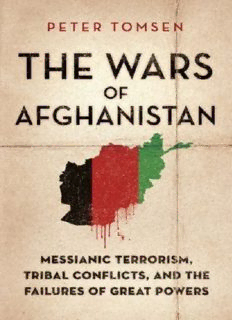
The Wars of Afghanistan: Messianic Terrorism, Tribal Conflicts, and the Failures of Great Powers PDF
Preview The Wars of Afghanistan: Messianic Terrorism, Tribal Conflicts, and the Failures of Great Powers
Table of Contents Title Page Dedication Table of Figures Introduction NOTE ABOUT TRANSLITERATION CAST OF CHARACTERS PART I - TRIBAL INCUBATOR CHAPTER 1 - Padshahgardi CHAPTER 2 - Shatter Zone CHAPTER 3 - Tribe and Mosque CHAPTER 4 - Modernizing Monarchs CHAPTER 5 - Red Sunrise PART II - FISSION CHAPTER 6 - Commissar Meets Tribesman CHAPTER 7 - Big Fox Catches Little Fox CHAPTER 8 - Green Dawn CHAPTER 9 - Insubordinate Puppets CHAPTER 10 - The General’s Vision PART III - MISSION TO THE MUJAHIDIN CHAPTER 11 - Mission Impossible CHAPTER 12 - Potemkin Government THE MULLAH WARRIOR THE IKHWANI THE WAHHABI THE PRESIDENT THE RELUCTANT PIR A GENTLE RASPUTIN CHAPTER 13 - Pakistan Pivots CHAPTER 14 - Tilting at Windmills CHAPTER 15 - Wahhabi Emirate CHAPTER 16 - Desperately Seeking Moderates CHAPTER 17 - Irreconcilable Policies CHAPTER 18 - From Marx to Mullahs CHAPTER 19 - From One War to the Next PART IV - AMERICA AND AFGHANISTAN CHAPTER 20 - Unholy Alliance CHAPTER 21 - Between the Lions CHAPTER 22 - Yankee Meets Tribesman CHAPTER 23 - From Victory to Stalemate CHAPTER 24 - Needed: Real Change CHAPTER 25 - The Way Ahead DESTINATION 2020 A NEW U.S. POLICY Acknowledgements APPENDICES NOTES INDEX Copyright Page Table of Figures FIGURE 4.1 SEEDS OF THE MUSAHIBAN ROYAL RIFT FIGURE 6.1 MAJOR SOVIET INSTITUTIONS MAKING AFGHAN POLICY FIGURE 10.1 ARAB GROUPS COOPERATING WITH THE ISI ON THE PAKISTANI FRONTIER, 1980–1989 FIGURE 11.1 MAJOR BUREAUCRATIC ACTORS ON AFGHAN POLICY FIGURE 12.1 THE SEVEN PESHAWAR PARTY LEADERS FIGURE 14.1 PAKISTANI PRIME MINISTERS DISMISSED, 1990–1999 FIGURE 23.1 AMERICAN PREEMINENCE, AFGHAN DEPENDENCE Dedicated to my amazing wife, Kim INTRODUCTION America and its allies are mired in Afghanistan’s endless war. It is still possible to achieve an acceptable outcome, but only if our policies respect Afghan history and culture and we heed the lessons of past foreign interventions. That is why I wrote this book. My motive sprang from concerns for our national interests and the desire of Afghans, Americans, and the broad international community to break the cycle of tragic wars in Afghanistan. I have been personally involved in Afghan affairs for over two decades, including three years as U.S. special envoy to the Afghan resistance (1989– 1992). This book reflects my firsthand experiences as well as my interviews of other eyewitnesses. It also draws upon the works of scholars, historians, journalists, and diplomats. It plows new ground in over six hundred newly declassified State Department, Pentagon, and CIA documents. It traces the sagas of the major actors since the 1979 Soviet invasion, many of whom I have known well. Where possible, I have presented documentary evidence and references to back up explanations and conclusions. The opinions and characterizations in this book, however, are my own and do not represent official positions of the United States government. There has been an explosion of documentaries and commentary on Afghanistan since 9/11. But a pervasive ignorance about this unique country and its history, culture, and tribal society persists in the West. Our misreading of the Afghan environment and Pakistan’s intentions in Afghanistan are the main reasons why America and the international coalition are today bogged down in the Afghan quagmire, wondering how this has happened despite the commitment of over 100,000 troops and $330 billion. If the United States does not change its policies, conditions in Afghanistan will look even worse in 2014 when the American-led combat troop drawdown is tentatively scheduled to end and the next constitutionally mandated Afghan presidential election is to take place.
